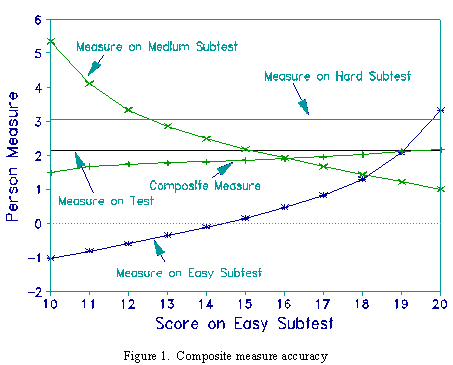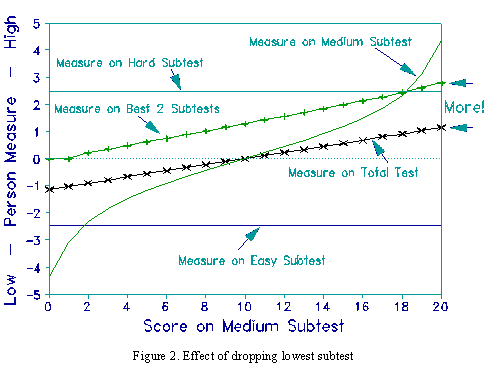
How do subtest measures combine to make test measures? Subtest scores add up to make test scores. Each subtest score implies a person measure, as does the score on the total test. What is the relationship between these measures? If examinees behaved consistently, their subtest measures would be about the same as their test measures. But that doesn't always happen. Is the test measure the arithmetic mean of the subtest measures? No, because score-to-measure conversion is non-linear, in fact, ogival.
A useful approximation to the test measure is obtained from subtest measures by computing their inverse-standard-error-weighted average RMT 8:3 p. 376):


|

|
This is illustrated in Figure 1 for a test comprising 3 subtests. In this Figure, the total score (and so the measure) on the test is held constant, as is the score (and so the measure) on the hard subtest. Scores are assigned to the easy and the medium subtest so that scores on the 3 subtests sum to the total score. From the three subtest scores, subtest measures are estimated. These measures are combined into composite total measures using the formula. It is seen that the composite measure is usefully close to the total test measure.
Dropping Lowest Subtest Measure
Unfair to Low Performers!
The formula for combining subtests also reflects Ryan Bowles' counter-intuitive finding that dropping the subtest with the lowest measure can boost the measures of higher performers more than lower performers! For example, in Figure 2, the score on high and low subtests is held constant. The score on the medium subtest varies. The overall measure according to the two best subtest measures is always greater than that for the total test. But it is the high performers on the total test who gain the most! Dropping the lowest subtest for low performers moves them up and nearer to the center of the measurement range of the test, where the score-to-logit conversion is low. Dropping the lowest subtest for high performers also moves them up, but away from the center of the test, where the score-to-logit conversion is higher.
Ryan Bowles
Computer Adaptive Technologies, Inc.
Combining and dropping subtest measures Bowles, R. … Rasch Measurement Transactions, 1999, 13:1 p. 686
| Forum | Rasch Measurement Forum to discuss any Rasch-related topic |
Go to Top of Page
Go to index of all Rasch Measurement Transactions
AERA members: Join the Rasch Measurement SIG and receive the printed version of RMT
Some back issues of RMT are available as bound volumes
Subscribe to Journal of Applied Measurement
Go to Institute for Objective Measurement Home Page. The Rasch Measurement SIG (AERA) thanks the Institute for Objective Measurement for inviting the publication of Rasch Measurement Transactions on the Institute's website, www.rasch.org.
| Coming Rasch-related Events | |
|---|---|
| Jan. 16 - Feb. 13, 2025, Fri.-Fri. | On-line workshop: Rasch Measurement - Core Topics (E. Smith, Winsteps), www.statistics.com |
| Apr. 8 - Apr. 11, 2026, Wed.-Sat. | National Council for Measurement in Education - Los Angeles, CA, ncme.org/events/2026-annual-meeting |
| Apr. 8 - Apr. 12, 2026, Wed.-Sun. | American Educational Research Association - Los Angeles, CA, www.aera.net/AERA2026 |
| May. 15 - June 12, 2026, Fri.-Fri. | On-line workshop: Rasch Measurement - Core Topics (E. Smith, Winsteps), www.statistics.com |
| June 19 - July 25, 2026, Fri.-Sat. | On-line workshop: Rasch Measurement - Further Topics (E. Smith, Winsteps), www.statistics.com |
The URL of this page is www.rasch.org/rmt/rmt131f.htm
Website: www.rasch.org/rmt/contents.htm